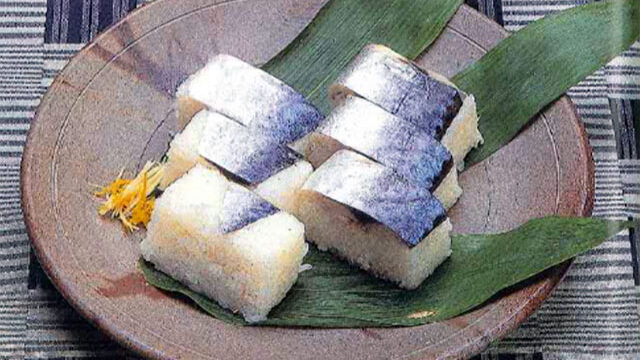
Alright, let’s head inland in Okayama and discover “Sabazushi,” a special pressed sushi made with mackerel. You might be surprised to find a fish dish so far from the coast, but there’s a fascinating reason behind it!
Dish Name: Sabazushi / さばずし
- Region / Location: Maniwa City, Takahashi City, Okayama Prefecture.
- Primary Area of Tradition: Maniwa City, Takahashi City.
- Main Ingredients: 鯖 (Saba/mackerel).
How It’s Eaten / Served
To prepare “Sabazushi,” salt-cured mackerel is rinsed, filleted into three pieces, and marinated in a vinegar mixture for one to two days. The mackerel is then removed from the vinegar, and any excess moisture is carefully wiped away. A mold is lined with plastic wrap, the mackerel is placed inside, and sushi rice is packed on top. The mold is pressed, wrapped tightly, and then removed. Finally, the sushi is wrapped in bamboo leaves, lightly weighted, and left to rest overnight.
Cultural Background and Preservation
It’s interesting to note that despite being a mountainous region, northern Okayama has a tradition of many fish dishes. “Sabazushi” is a special treat enjoyed mainly in northern and central Okayama during autumn festivals. Back when transportation was difficult, it was hard for mountain villages far from the sea to get fresh fish, which spoils easily. So, they came up with the idea of using salt-cured fish, brought from Tottori Prefecture on the Sea of Japan side, to make a festive dish for the autumn celebrations.
While there are some regional variations, “Sabazushi” was typically made for autumn festivals and celebrations after rice planting in most areas.
During the autumn festivals, families would buy a large amount of mackerel and make a lot of “Sabazushi” to share with relatives and friends or to serve guests. Also, since rice harvesting took place after the autumn festival, they would make extra “Sabazushi” to eat during the busy workdays.
Even though you can make “Sabazushi” any time of year using salt-cured mackerel, it’s considered most delicious when made with fresh autumn mackerel.
Today, “Sabazushi” is still made at home for autumn festivals and is also sold at roadside rest stops (Michi-no-Eki) and served in restaurants that specialize in local cuisine.
Additional information:
- Saba (鯖): Mackerel.
- Michi-no-Eki (道の駅): Roadside rest areas in Japan that often sell local products and food.
The information about regional cuisine featured on this website (Piggy's Grandma of Japan) is summarized and adapted from the Ministry of Agriculture, Forestry and Fisheries of Japan (MAFF) website, "Our Regional Cuisines"Additional commentary is provided based on the unique experiences and perspectives of the site's editors.
The copyright for the original content regarding regional cuisine belongs to the Ministry of Agriculture, Forestry and Fisheries of Japan.
The summaries and adaptations published on this site are intended for informational purposes only. Piggy's Grandma of Japan does not guarantee the accuracy or completeness of this information. For the most accurate and complete details, please refer to the original pages on the MAFF website.


